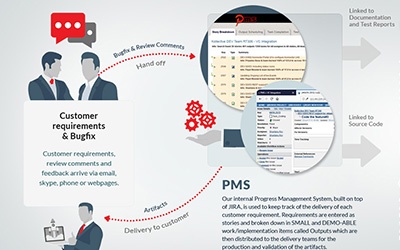It’s about them, not you
Remember that one-to-ones aren’t about you and your needs. They’re about the employee. This means that your time should be spent asking great questions and actively listening to what your team member has to say. The meeting is not about updates on tasks and projects, but it does give the employee the platform to voice his or her concerns about things like team relations and resources constraints, as well as the employee’s personal career development.
This is also the time to ask your employee for feedback on you. What could you be doing to help him or her be more successful? What behaviors do you have that are challenging to your employees? And here is the hard part: Don’t get defensive. Listen to your employee’s views and just say “thank you.” Doing this will help you, as a leader, have better interactions with the employee and ultimately increase employee engagement and productivity.
Change up the environment
More often than not, one-to-ones happen in a manager’s office or conference room. Every once in a while, you should change it up. Take your one-to-one outside the office to a nearby park or just the surrounding grounds of your building. Walking and talking has huge benefits in building relationships, creativity and health. Go to the building café and meet over a cup of coffee, or go off-site for lunch. Making the one-to-one relaxed will help put employees at ease and encourage them to open up and be transparent.
Make it a dialogue
A discussion’s emphasis is not about learning but winning, while dialogue is just the opposite. The primary purpose of a dialogue is to expand ideas, not to diminish them. It’s not about winning acceptance for your viewpoint, but exploring options and gaining agreement on next steps. This is really important, to continue to build trust from your team member.
Coach them
When you spot a trend or theme with your employee that could hold him or her back, it is time to put your coach hat on. Remember that coaching is different from mentoring. The goal of coaching is to ask questions that allow your employee to reflect on how his or her behaviors and actions are impacting others, to explore options on how to adjust and to make the commitment to take action.
Make your points accountable
Before concluding the one-to-one, make sure that each of you has actionable items you are responsible for. The items should follow the SMART goal model: “specific, measurable, attainable, realistic and time-sensitive.” And at your next meeting, the first thing you should check in on are those items you committed to in the previous meeting.
Give clear feedback
Before reprimanding an employee for his or her effort (or perceived lack of it), give that person as much feedback as possible. If the quality of the work has taken a nosedive, speak to the employee. Communicate what’s changed, how the person’s approach should be modified and the time frame that’s been granted for turning things around. Sometimes all people need is a nudge in the right direction.
Listen to points of contention
Communication is a two-way street and leaders should be prepared to listen to an employee’s point of view. Is there a reason for the attitude change? Has the employee stopped putting in effort because of unhappiness over something? Unearthing the cause of the problem is key
Address companywide concerns
If an employee highlights a concern that could affect more than one person, be sure to address it. If a single staffer feels as though he or she is overburdened by work, in all likelihood others might feel the same way.
A great way to deal with a situation like this is to call a meeting with representatives of the relevant departments to discuss company culture: What would they like to see improve and how can members of the team accomplish this? At the beginning of the meeting be clear that this is an open forum where employees are free to air grievances without fear of repercussion.
Highlight the fact that the aim of the meeting is to find a solution to any problems, rather than to serve as an opportunity to vent. This collective approach will help employees feel valued and part of the company’s development — a morale booster in itself.
Find out what makes an employee tick
It’s very hard to direct someone without understanding what makes him or her tick. Take the time to get to know employees: What are their long-term goals and aspirations and where would they like to see their career headed in the next one to three years?
Sometimes employee disengagement stems from feeling undervalued (as opposed to resentment over too much work) and the only way to overcome this is by understanding the people involved. With this knowledge, it’s possible to ensure that staffers are assigned to the right roles and tasks.
Create performance goals together
It’s critical to include employees in the process of outlining individual performance targets. Ask staffers how they would like to improve, what they would like to achieve and the new skills they want to learn. Inviting this level of engagement will motivate employees to work hard and strive for betterment.
Follow up
A good leader always follows up with employees. Once a goal is set, be sure to monitor the progress. If someone has been asked to complete a task by a certain date, be sure that he or she has accomplished it.
Successful leaders hold their employees accountable. Most people will appreciate this structure at work and respect the manager’s due diligence. Showing an interest in the work of employees can significantly boost a company’s culture and morale.
Recognize and reward improvement
One surefire way to alienate disengaged employees is to ask for improvement, only to forget to reward progress after the effort is put in. Be sure to recognize such accomplishments and congratulate employes upon their rethinking their approach to the business.
Continue to provide feedback on performance and reward employees when it’s relevant to financial incentives or more responsibility. Often a simple mention of “thank you” or “well done” goes a long way.
Formally act on continued underperformance
If an employee continues to underperform, a manager should formally address this behavior. This lets the employee know the manager is serious and won’t tolerate attitudes not conducive to group dynamics. Furthermore, the members of a team who are indeed working hard will become disengaged if they see individuals slacking off without repercussions.
Know the right time to cut ties
Letting someone go from a business is never ideal and should be treated as a last resort. But if an employee continues to flout the rules, underperform and spread negativity, cut the ties. Holding onto underachieving employees could result in a ripple effect of negativity, low morale and poor quality of work.





